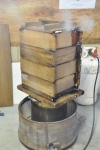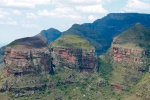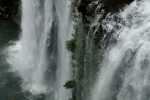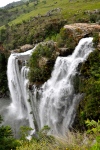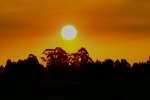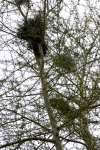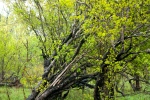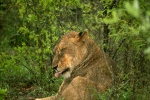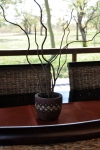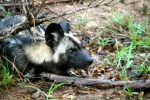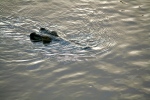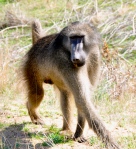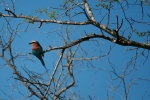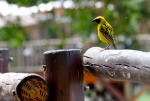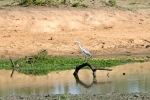We started our morning game drive at what is known as the ‘bird hide’, where we quietly observed the birds in their natural habitat from behind a camouflaged structure. The standout moment came when an African Jacana made his stage debut and walked nonchalantly from one lily pad to the next, similar to a ballet dancer tiptoeing across the stage. Such elegance, such serenity! We aslo caught a Kingfisher with a smelt in his mouth. I’m sure that he didn’t think twice about sharing his prized catch with us, especially since it was no bigger than a tiny earthworm. Our safari then took us through the wilds of Kruger, where we caught the tail end of 500+ buffalo traversing the plains and a pack of kudus being de-ticked by a red-billed oxpecker. To maintain a stable ecosystem in the bush, we’re finding that every creature, big and small, has a purpose, some as predators and others as prey.
Today was the transition day, where we did our morning game drive at Kruger and our afternoon game drive at Sabi Sands. Although Kruger and Sabi Sands are neighboring parks, we had to travel three and a half hours through the communal area to get to the main entrance at Sabi Sands. We found the communal areas to be very interesting, as there were a number of cinder block houses that were partially constructed, but without any material left to complete the production. We asked ourselves why that would be the case, but couldn’t come up with a logical reason. We were later told that these houses were built block by block, and only when the owners had the resources to pay.
When we got to the Sabi Sands, and more specifically the Nkorho Bush Lodge, one of the resorts therein, we were amazed at how awesome the accommodations were. It was very luxurious, with all the amenities, including a private outdoor shower area, dual basin, dual indoor showers and a beautifully decorated king-sized bed. The grounds were amazing, with an infinity pool, clubhouse and covered outdoor dining and sitting area. We were greeted by Milo, a 16-year old Jack Russell Terrier. Since he was getting up in age, he spent most of the day sleeping in the clubhouse.
We arrived in the early afternoon, just in time for lunch, which some would call ‘lunner’, a combination between lunch and dinner, that was served at 2:00 p.m. To gather the guests for meals, we’d hear the sounds of the African drum that would reverberate through the bungalows. It was a very unique experience, but one that was relaxing and interesting. Looking out at the waterhole in the distance, we saw a number of animals traversing the fields. It was so apropos, given that we were in Africa. The meals were great and we feasted primarily on beef, contrary to what you’d expect. We had a preconceived idea that we’d eat some form of ‘big game’, but in retrospect, that wouldn’t be quite so appropriate, as that’s what you’re there to experience….and not to poach.
Our afternoon game drive started a 4:30 p.m. as planned, despite the heavy rains. Our guide received a call from a neighboring guide that there were wild dogs in the area. Without getting the full range of instructions that normally precedes the drive, we sped off in the open-air vehicle, with the rain whipping in our faces. Our guide skillfully negotiated the unpaved road, avoiding the many water puddles along the way. Those of us in the back of the vehicle were bouncing up and down and holding on for dear life. Could we have fallen out of the vehicle? Yeah, but we had travel insurance if the dogs thought that we were tasty enough. Was it a huge rush? Totally!!! It was exhilarating. It was thrilling. And yes, it was CRAZY!!! All told, we loved it!!
After 15 minutes of swerving from side to side in the sleeting rain, we finally saw the prize that we were in search of….25 wild dogs running freely in the Savannah. We were extremely fortunate to have seen these nearly extinct dogs, especially since there are only 250 remaining in the area. Since these dogs are closely inbred, the species has gotten weaker over the years and as a result, the sightings are far and few. The dogs normally travel in packs, and because of their lean structure and long legs, they’re able to chase their prey until they’re exhausted. They’re quite beautiful, but when they flash their canines, they look ferocious. That look, however, didn’t intimidate the spotter, that sits at the very front of the open-air vehicle,without any protection. To add some perspective, we were so close to these animals that we were able to get a whiff of their odor…..which would totally be enough to down a cow!!
Our journey then took us to the sight where a rhino was killed a few weeks prior. When we arrived, the savage hyena was tugging at the head of the rhino, eating whatever was left of the carcass. Our guide witnessed the actual killing and was still shaken up by what he saw. Apparently, two male rhinos fought ferociously for dominance in the group, one sustaining severe wounds that weakened him and made him unable to defend himself. As the group moved on, the injured rhino was left on his own. A hyena then took advantage of the situation and attacked the rhino’s open wound, eating his flesh and biting off his ear, all while the rhino was still alive. This gives meaning to the phrase ‘eating him alive,’ and it is also why the hyena has such a bad reputation in and out of the bush. The ghastly sight was witnessed by those that were on safari that morning, many of whom could not bear to watch the suffering rhino. Finally, after a hard fought fight, and the rhino having been in a lot of pain and bleeding profusely, he was still. It was a very somber moment and one that will remain with the guide forever. Even for those of us listening to the story, it was heart wrenching and sad.
Since our trip began, we were wondering about the possibility of seeing a leopard and were told that our chances were quite good, especially at Sabi Sands, where the focus is on the ‘big five’. We had heard that of the big game, the leopard was the most elusive because of his shy nature. On our first game drive at Sabi Sands, however, we were lucky that the spotter saw him lying in a bush near the roadside, miserable in the pouring rain. His skin glistened in the rain and surprisingly, he looked a lot smaller than we imagined. We watched him for a few minutes as he fell back to sleep, not caring that we were right next to him with our lights shining directly on him. Before turning in for the night, we circled a ten mile loop and again saw the same leopard crossing the road. While he didn’t stand still for us, he looked much more muscular and much bigger than he did in his curled up position.
After returning to the lodge, dripping wet and cold, we were greeted with hot towels and a glass of blue curacao. At that point, we knew why we had such a burning desire to go on an African safari. Despite the rain, it was a near perfect drive.
More to come…






















